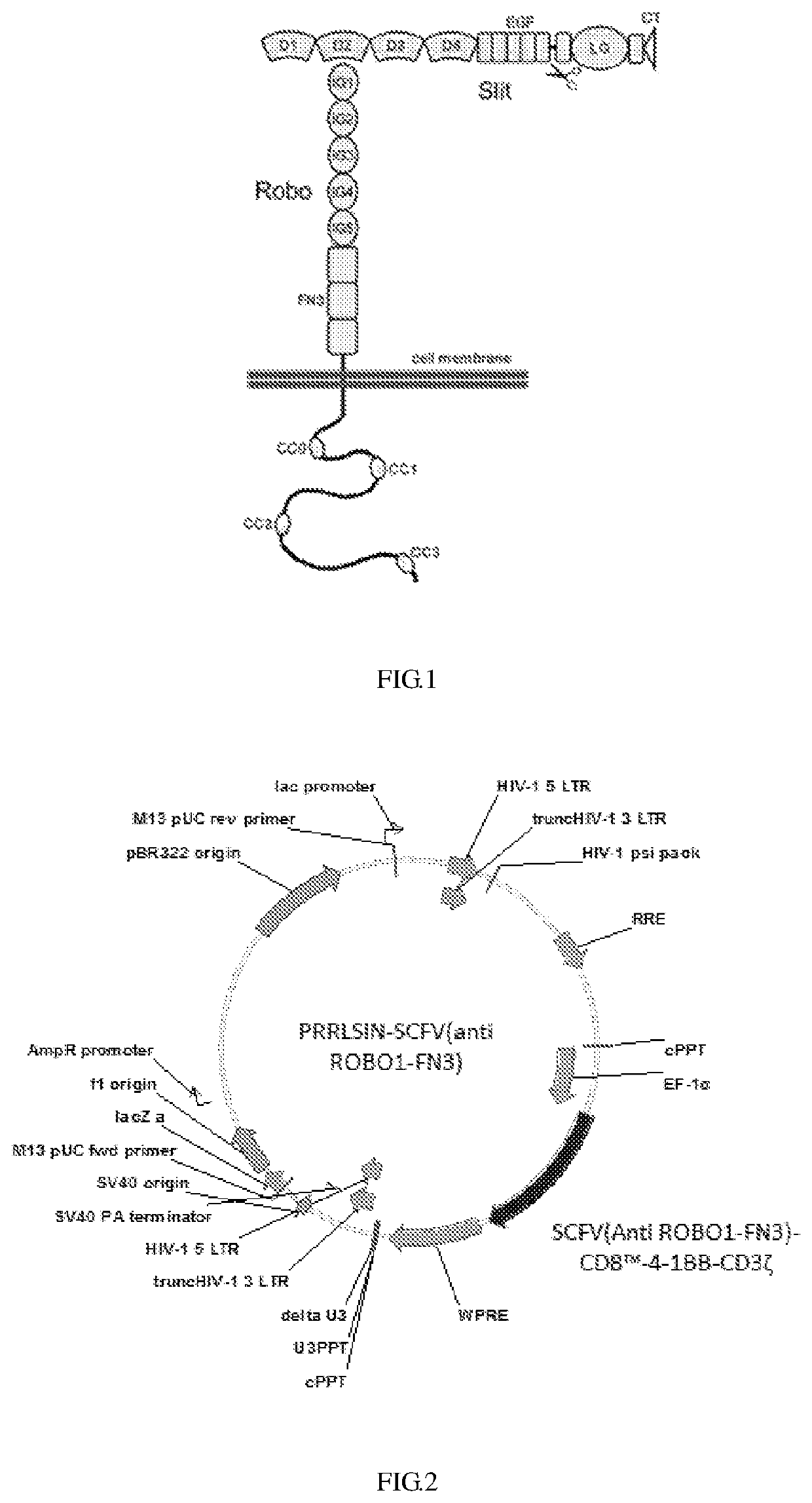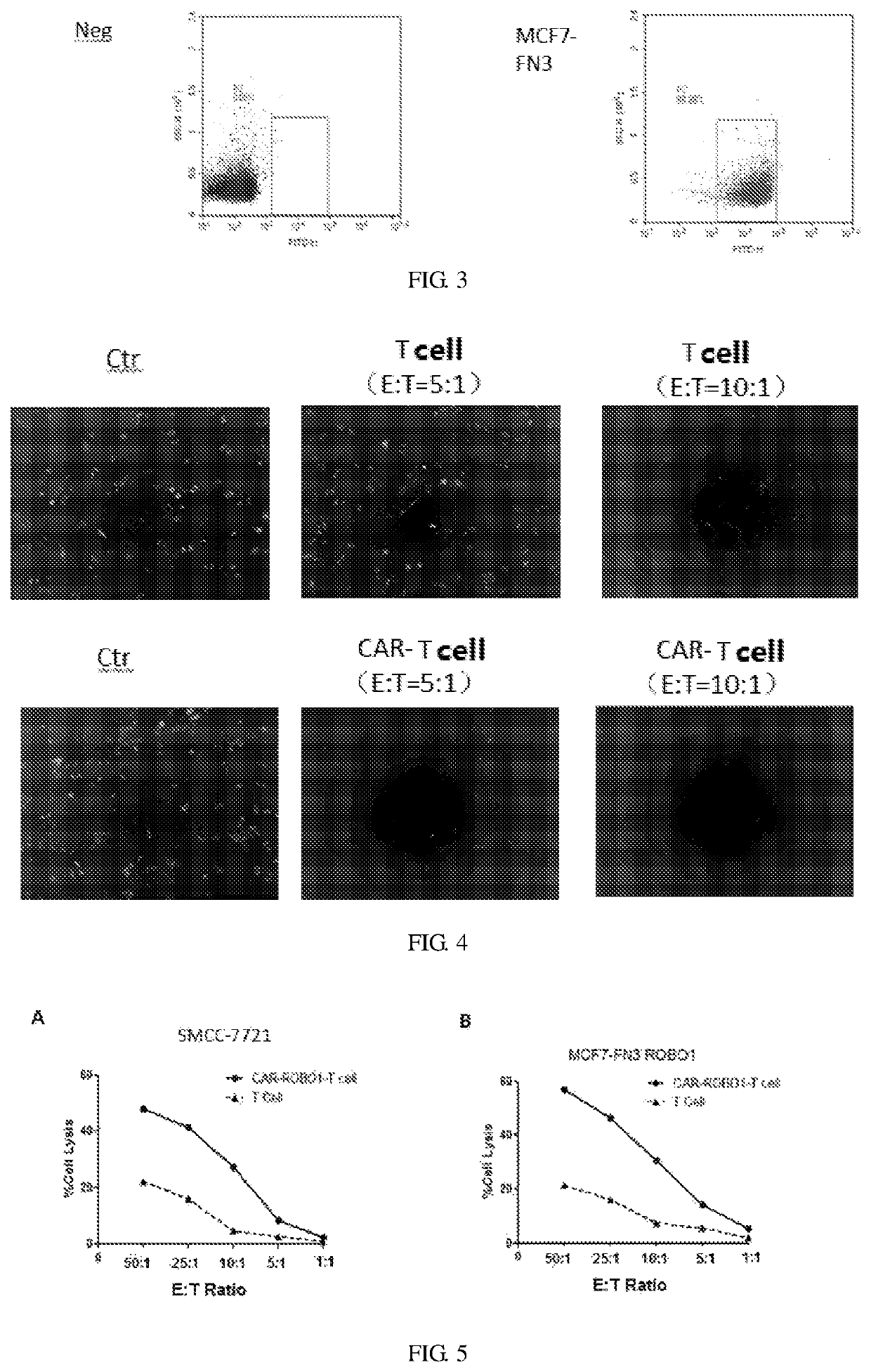Anti-ROBO1 CAR-T cell, and preparation and application thereof
a technology of anti-robo1 and cart cells, which is applied in the field of cell-based drugs for tumor therapy, can solve the problems of many problems to be solved, and the number of t lymphocytes is too small to treat cancer, and achieve the effect of more efficient tumor killing activity
- Summary
- Abstract
- Description
- Claims
- Application Information
AI Technical Summary
Benefits of technology
Problems solved by technology
Method used
Image
Examples
example 1
on of a Lentiviral Expression Vector
[0030]Synthesizing the gene encoding the SCFV (Anti ROBO1-FN3)-CD8-4-1BB-CD3ζ; wherein the gene sequence is SEQ ID NO:7, then the gene was ligated into the PRRSLIN vector by restriction enzyme and transformation, and the upstream of the gene is EP-1α promote. The vector was transformed into Stbl3 Escherichia coli strain and screened by ampicillin to obtain positive clones, then the plasmids were extracted and identified by restriction enzyme digestion, and PRRLSIN-SCFV (anti ROBO1-FN3) lentiviral transfection vector was obtain, the structure of which is as shown in FIG. 2.
embodiment 2
of Lentivirus
[0031](1) Twenty-four hours before transfection, seeding 293T cells into 15 cm culture dishes at a cell density of approximately 8×106 cell per dish, which could ensure that the cells were at about 80% of confluence and evenly distributed in the culture dish during transfection.
[0032](2) Prepare solution A and solution B
[0033]Solution A: 6.25 ml of 2×HEPES buffer (using 5 large dishes which are packed together could achieve the best effects).
[0034]Solution B: adding the following plasmids respectively, and mixing: 112.5 ug of pRRLSIN-EF-ROBO1 (target plasmid); 39.5 ug of pMD2.G (VSV-G envelop); 73 ug of pCMVR8.74 (gag, pol, tat, rev); 625 μl of 2M calcium ion solution. Total volume of solution A: 6.25 ml.
[0035]The solution B was mixed completely, and the solution A was added dropwise when the solution A was gently rocked, then let the solution sit for 5-15 minutes. The above mixed solution of A and B was gently rocked and added to the petri dish containing 293T cells dr...
embodiment 3
[0036]Preparation of Anti ROBO1-FN3-CART Cells:
[0037]0.5 ml of blood was taken, and tested for pathogenic microorganisms rapidly to exclude microbial infections such as HBV, HCV, HDV and HEV, HIV-1 / 2, Treponema pallidum and parasites; 50 ml of blood was collected with heparin bottle (heparin anticoagulation) under sterile conditions, and immediately (4° C., within 24 hours) sent to the cell preparation laboratory to ensure that this process was free of pathogenic microbial contamination. After obtaining the patient's blood, the surface of the heparin bottle was wiped with an alcohol cotton ball for disinfection in the GMP preparation room, then the heparin bottle was placed in a biological safety cabinet. Two 50 ml centrifuge tubes were opened in advance, and the blood was transferred into the two 50 ml centrifuge tubes and tightened up. The above 50 ml centrifuge tubes filled with blood were placed in a centrifuge and centrifuged at 400 g (2000 rpm) for 10 min at room temperature, ...
PUM
| Property | Measurement | Unit |
|---|---|---|
| concentration | aaaaa | aaaaa |
| density | aaaaa | aaaaa |
| density | aaaaa | aaaaa |
Abstract
Description
Claims
Application Information
 Login to View More
Login to View More - R&D
- Intellectual Property
- Life Sciences
- Materials
- Tech Scout
- Unparalleled Data Quality
- Higher Quality Content
- 60% Fewer Hallucinations
Browse by: Latest US Patents, China's latest patents, Technical Efficacy Thesaurus, Application Domain, Technology Topic, Popular Technical Reports.
© 2025 PatSnap. All rights reserved.Legal|Privacy policy|Modern Slavery Act Transparency Statement|Sitemap|About US| Contact US: help@patsnap.com


